“I don’t know about you, but I fail a lot,” Nick Mehta, CEO of Gainsight, says as his opener at SaaStr Annual 2023.
In SaaS, we talk a lot about hyper-growth, uber-successful companies, but many founders, including hyper-growth founders, make mistakes over and over. In this talk, Nick shares his top 10 failures as a CEO while getting to $200M ARR. Maybe you feel SaaS is crushing it this year, but it’s not easy for a lot of folks. Being open about mistakes helps others see that you can win at business while still being human-first.
Failure #1: Not Holding Leaders To The Highest Standard
As a founder, CEO, or leader, you need to hold other people to the standards you hold for yourself. What are the things that matter to you the most? Or are the most critical? Can you hold the people who work for you to those same standards?
In leadership, there’s a great expression that “to those who much is given, much is expected.” At Gainsight, you’re expected to do a lot, and it’s hard. But you have to hold yourself to the highest standards because your team relies on it.
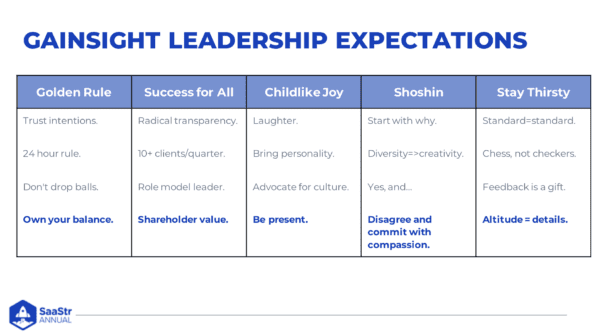
Whatever you care about in your business, whether high achieving, innovation, values, or making money, make sure your team feels the same way. If they don’t, you need a different team. The whole thing falls apart if you have a vision as a founder or functional leader and the people underneath you don’t believe the same things. It becomes a house of cards.
The Takeaway: Hold your leaders to the highest standard possible. At Gainsight, it’s really hard to be a leader. You have to lead the team, live up to the values, hit quotas and targets, and make money. What does that look like practically? For leaders, be clear about expectations. Make a list of behaviors and values that are 100% mandatory for leaders.
Failure #2: Not Betting On The Team That Got You There
Don’t forget there are some great people who got you where you are that can do more in the company. This is a common mistake founders make — getting a new Head of X when you get to a certain point in business, missing a sales number, the product isn’t what you want, there’s too much churn, etc.
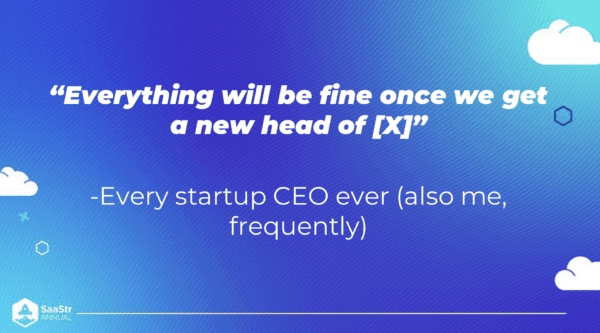
Sometimes, that’s true and you have to look outside of the company for your next great hire. But Nick admits that he’s swung and missed on way more executive hires than he’s hit on.
His executive team today is:
- A Chief Customer Officer who was CSM at Gainsight seven years ago.
- A Head of Sales who was a sales rep nine years ago.
- A CMO who was the person doing sponsorship sales six years ago.
- The CFO who was the Head of FP&A.
This list goes on. Almost everyone grew up in the company.
The Takeaway: People often say you should hire for the person you need four years from now because you’ll be growing fast. Most people aren’t growing as fast as they were a few years ago, so you kind of have to hire for who you need now and in the next year, and hope they grow with you.
Failure #3: Not Scaling Based On Leading Indicators
There’s a big fallacy in software. Let’s look at an example: You want to generate $10M in bookings this year. Your average sales quota is $1M. So, you need ten sales reps to reach your goal. If this was true, why not hire ten more to get to $20M and 1,000 more to get to a billion? It’s an old-school concept when one vendor is in a space with infinite demand.
At Gainsight, they’ve scaled too fast many times. Three moments when they scaled too fast include:
- Assuming an Enterprise opportunity for CS after closing only one Enterprise deal.
- Scaling newly acquired raw technology too soon.
- In 2022, misreading the “COVID bump” for a secular change.
For the Enterprise deal, they closed their first gigantic deal at $2.6M ARR around 2015. They thought it was the beginning of the next phase, hired ten Enterprise reps, and built a team. They didn’t close another million-dollar deal until five years later!
The Takeaway: “Fire bullets, not cannonballs,” as Jim Collins says. Constantly run small experiments and scale only based upon clear leading indicators.
Failure #4: Not Investing In Systems
This is a big mistake many make in the beginning, and it can be challenging to recover from. For example, if you have a customer or prospect that says, “Can I get this for $300/month and a one-year contract,” or, “I’d like a three-year contract with one-year opt-out and to pay on quarterly terms.” As a desperate entrepreneur, you say yes to these deals.
It’s a trap. You should be flexible unless you’re an Atlassian who doesn’t have contracts or negotiations. But, you need some element of discipline because a lot of these desperation deals at the end of the quarter almost all blow up later — bad customer success; impossible to scale.
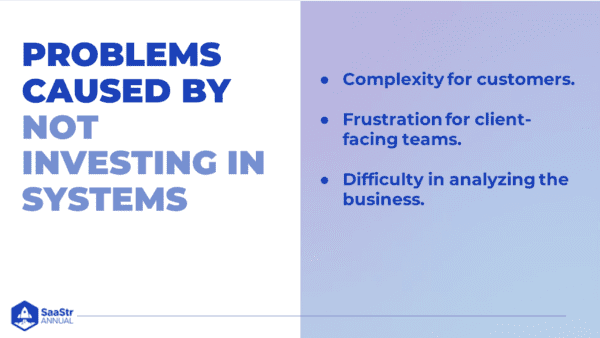
They create this problem where you end up with a lot of complexity for customers because how do you renew this thing? Early stage might not be dealing with this, but if you do what every deal wants, you’ll have problems later.
The Takeaway: Be really careful about custom deals that feel tempting in the moment. Make sure they’re worth it. Invest in back-office systems early.
Failure #5: Not Investing In Digital Customer Success Early Enough
Eventually, you hire a ton of people, and it’s chaos. You need to get to a point where you scale through digital CS and every self-service thing you can do. Self-service makes it so the people you hire will be much more of a value add. People often hire CSMs as a bandaid over the customer experience or product, so don’t work on those things first. Instead, create a playbook to improve customer success.
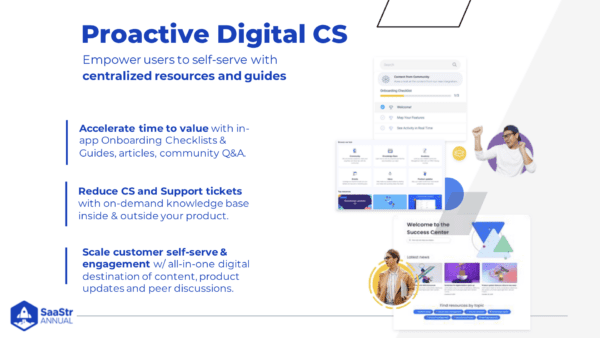
The Takeaway: Invest early in Digital Customer Success capabilities for all customers — like self-service, community, in-app engagement, telemetry, digital journeys, and PX-CS feedback loops.
Failure #6: Not Parting Ways Well
Unfortunately, in business, there are a lot of parting ways, especially this year. It’s hard!
There are two ways someone leaves a company:
- The company parts ways with the teammate.
- The teammate parts ways with the company.
The truth is, a lot of companies don’t part ways well. It’s heartbreaking to hear stories of people who experienced a company treating them like they were dead to them and wouldn’t help them in the future. Someone who works for you and does so much for you should be treated well.
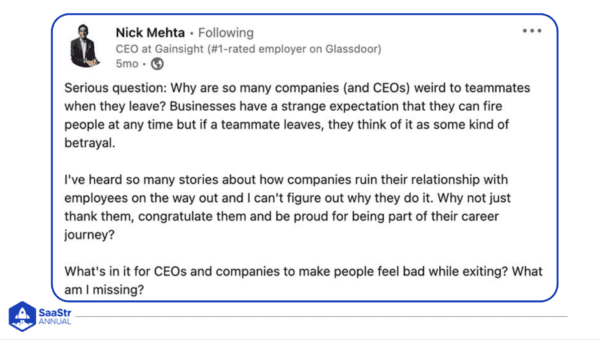
The Takeaway: End every relationship in a human-first way. When the company parts with the teammate, see how you can help them with their job search. When a teammate leaves the company for another job, celebrate them on LinkedIn or send them a bottle of champagne. You never know when great alumni members will refer great people or customers to you down the road.
Failure #7: Not Being Prescriptive Enough Early Enough
Gainsight’s first product was software to scale Customer Success teams. In 2013, people didn’t even know what Customer Success was. In the beginning, the customer would ask, “How should we implement your software?” The team at Gainsight didn’t know, so they’d say, “I don’t know. What would you suggest we do?” They went too long with letting people implement in different ways.
The problems caused by not being prescriptive enough include:
- Over time, this back and forth leads to a longer time-to-value.
- Every client uses you a little differently.
- It’s hard to ramp up new teammates in CSM and PS.
People talk about time-to-value, and the biggest issue isn’t the technology but how people implement it.
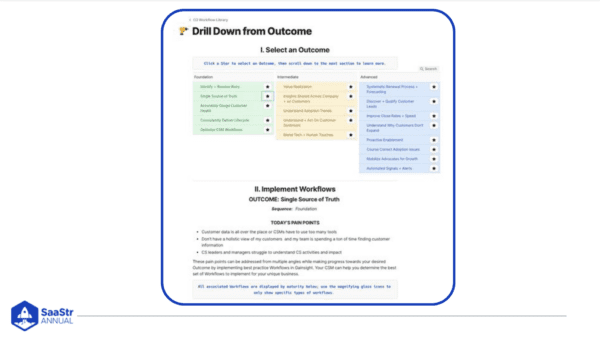
But being prescriptive is just as hard. It requires:
- Alignment across Product, Marketing, Sales, CS, and PS.
- The right granularity for each stakeholder.
- A way to keep it updated.
- Coaching teammates to be “brave” and tell clients the best way to get value.
The Takeaway: It wasn’t without its flaws, but a prescriptive methodology is one of the most critical step functions for any SaaS company in a new category.
Failure #8: Not Starting Act II Fast Enough
In the early days, you’re growing like crazy. At Gainsight, they went from $1M to $5M to $16M to $30M. It wasn’t Snowflake, but it was pretty good. Every business needs an Act II, though. What’s the next thing you’re going to do?
It could be a:
- new geography
- a new segment of the market
- new channel
- new product
One of the problems founders don’t think about early on is that you deal with gravity. Every market has a certain number of buyers, and at a certain point, you start selling to a lot of those buyers. That doesn’t mean you won’t sell to more buyers, but the number of new logos grows and grows and then flattens. Logo count might go from 10 to 20 to 60 to 80 each year. Then 85, 87, and 90 the following years. And it’s much harder to raise money if your company is slowing down.
The Takeaway: Track your TAM vigilantly and start your second act — organic growth or M&A — well before growth stalls.
Failure #9: Not Being Patient And Ignoring FOMO
There’s a lot of FOMO in tech, and people aren’t open about the challenges. You hear about this company going public or raising all this money — the Snowflakes, Klaviyos, and Databricks. You wonder, what’s wrong with me? Why am I not like that? You have to wait for it and be patient.
It doesn’t mean you should spend your life doing nothing if there’s no market. But it’s okay to be the tortoise instead of the hare, like Gainsight. Keep going and be persistent. If you don’t believe in your business, don’t wait for it.
The Takeaway: In many markets, the patient tortoise beats the over-anxious hare.
Stick to your values and vision and, in the words of Lin-Manual Miranda in Hamilton, “wait for it.”
Failure #10: Not Being Yourself
Nick has a certain style and way of speaking. Each year, Gainsight hosts a conference for CS called Pulse. The first year, 300 people came, and it was great — unscripted, playful, and Nick being Nick. It went so well that he decided to be a “grown-up CEO” and get a speaking coach.
She told him he talked too fast and his energy was too high. She told him to stand in one place and script out the speech. The following year, it was his worst keynote ever.
The Takeaway: Be yourself. Nothing can hold you back if you find the confidence to show up with authenticity and vulnerability. Being anyone else just won’t work.
To wrap up his top ten failures, Nick says we don’t talk enough about mistakes in tech, even though many of us make them. This year, “We can all be a little more human-first together.”
The post Nick Mehta, CEO Gainsight: My Top 10 Failures as a SaaS CEO & What I’ve Learned (Video + Podcast) appeared first on SaaStr.
via https://www.aiupnow.com
Amelia Ibarra, Khareem Sudlow
